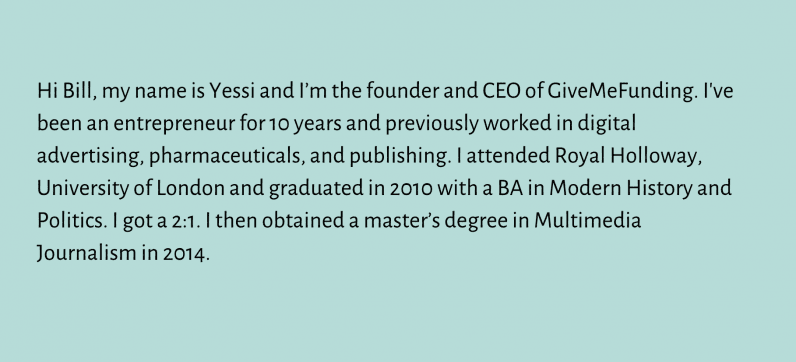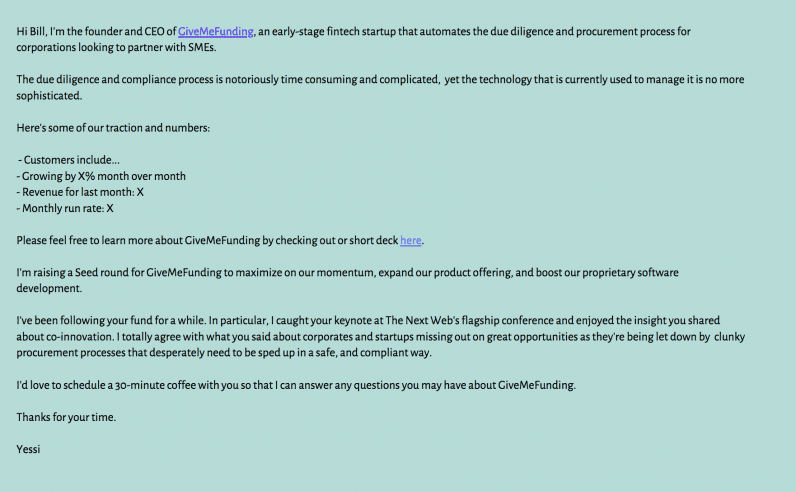
Coronavirus may have put a damper on your fundraising plans for now, but it doesn’t mean you can’t still reach out to venture capitalists and nurture relationships for the future
Investors often receive hundreds of emails every week and most successful founders make in-roads with a VC after a warm introduction.
I’d argue cold emails don’t always lead to good outcomes, but if you’re not lucky enough to know someone who can introduce you to a prospective investor, the onus is on you to make sure you do your research properly. If you don’t, well, you risk your email being instantly deleted.
[Read: Onfido’s CEO on how to play the fundraising game — stage by stage]
But don’t worry, here’s what you need to know to increase your chances of being seen regardless of whether you get a warm or cold intro.
Research, research, and research some more
Before you draft your pitch, think about what you are looking for in an investor, how you fit their criteria, and how you can angle what you do to get to engage with your proposition.
“Venture capitalists don’t want to receive long, cold emails about a founder’s ‘amazing idea.’ In reality, it is very likely that scores of entrepreneurs are working on similar areas. Instead, I want to hear about two things: You and the market opportunity,” Richard Anton, founder and partner of Oxx, tells Growth Quarters.
“Tell me about your track record as a founder or an operator and how this gives you the credentials to grow a business. And, rather than getting into the nitty gritty of the idea, tell me about the market opportunity. How large is the addressable market? Why does this business stand a chance of making an impact?” he adds.
You need to understand what the potential investor is interested in, why you may be an attractive opportunity, and what sets them (and you) apart from the competition.
Here are a few things to consider:
- Look at which companies they’ve backed in the past
- Can you discern any trends in the previous investment decisions?
- Are they sector agnostic?
- What’s their average ticket size
- Do they co-invest
- Are they stage agnostic (pre-Seed, Seed, Series A, etc)
- What is the average valuation of their portfolio companies
- What content are they sharing on social media: What are they tweeting and retweeting
Get them to open your email: The subject line
It’s important to manage your own expectations and prioritize what you want to get out of your email.
Remember the investor may have absolutely no idea about who you are and what you do, so your first priority should be for them to open your email.
Once you get over this first — and very important — hurdle, you then need to structure your email in such a way that it piques their interest. More on this later.
Investors are busy people and their inboxes really are the things of nightmares. If all you do is send a boilerplate template, I can guarantee you’ll get nowhere. Your email will be deleted and you would have blown your chances.
[Read: Looking to close a series A? This comprehensive Y Combinator guide can help]
If you want to avoid this, leverage the research you’ve done to craft a subject line that will get your investors’ attention.
Avoid generic stuff such as “VR startup seeking funding,” or “AI investment opportunity,” and try and be as specific as you can while also keeping your copy succinct.
For example, if your chosen investor backs Series A companies, your subject line could look something like this: “Just hit 10,000 customers, looking for Series A.”
The trick is to show the investor value right away, in one simple sentence that encapsulates where you’re at and what you need.
If you’re really lucky, the VC will open the email and even read what you’ve got to say.
Explain what you do
If your investor has opened your email, congratulations, but now the hard part begins: You need to make sure they understand what you do.
Format is key. A text-heavy email can be overwhelming, seem poorly thought out, and will probably get deleted.
“Short emails work better than long emails. Long emails get filed for ‘read later.’ Short emails get read. Try and offer clear call to action like ‘We should do a call for 15 minutes’ as opposed to ‘It will be good to discuss this’,” says Vishal Gulati, a Healthtech VC at Draper Esprit.
You need to keep momentum going and expand on your value proposition.
Explain what your company is all about succinctly and in language that is both clear and concise. No need to add superfluous terms, or sentences, as this will set you back. DON’T describe your company as the “Uber of X,” or “The Airbnb of X,” or anything along those lines. It’ll come across as lazy!

Despite Anton saying VCs want to hear about ‘you’ it doesn’t mean you can use up valuable space to share your life story.
Maximize your chances of getting a reply and sparking a conversation by being specific and outlining the problem your business is seeking to solve and the impact this would have on a wider industry basis.
Don’t tell the VC what’s interesting about you as a person but highlight your track record as a founder.

Including your pitch deck in a cold email can feel presumptuous but in my humble opinion attaching it means the investor has easy access to the information without having to ask for it.
The way I see it, by not including it, you are giving the investor yet another opportunity to delete your email. So, I’d take my chances.
You won’t close an investor over email
By sending a cold email you’re not necessarily asking for money outright — nor should you expect it.
You want to start a two-way conversation between you and the investor. You want to get on their radar.
Sign off with a call-to-action. You want the email to get you some time with the VC, be it on the phone, or in person.
This really goes without saying but you should never ask VC to book time with you.
You need to be the one who schedules the call or meeting around a time that suits them.
Quick reminder
Do your research — and do it properly
Lead with value: Think about what the investor must know and why.
Explain what you do
Explain why they should care
Start a conversation
Be flexible to their needs
Be prepared to ask and answer questions
Have you had success with cold emails? Then share your advice with our readers!
Get the TNW newsletter
Get the most important tech news in your inbox each week.




